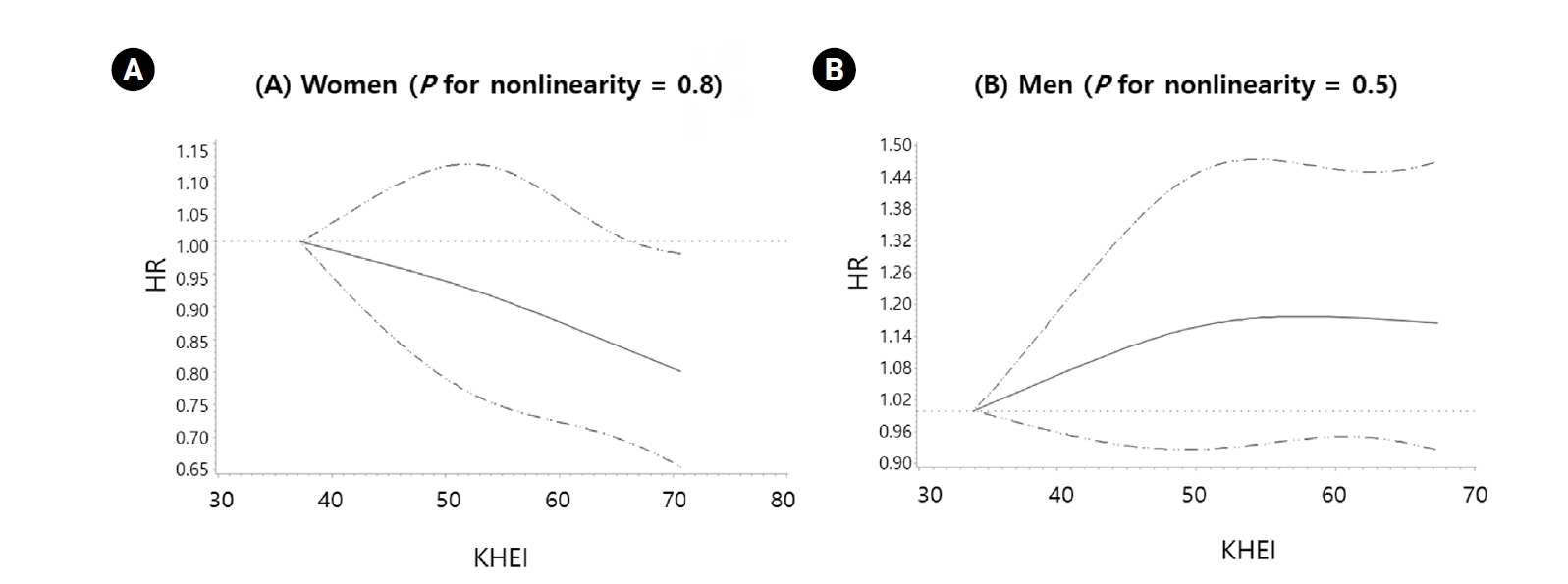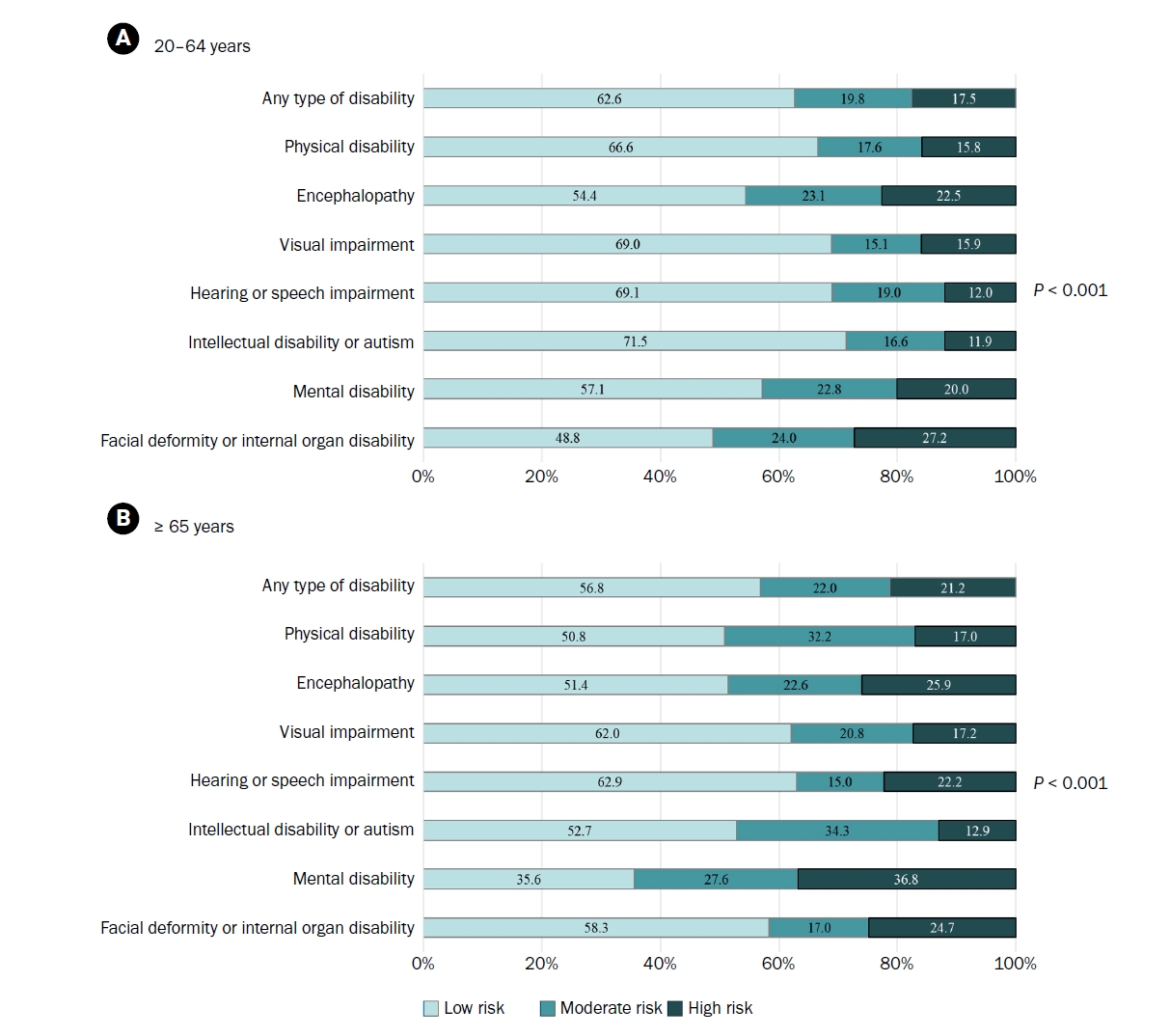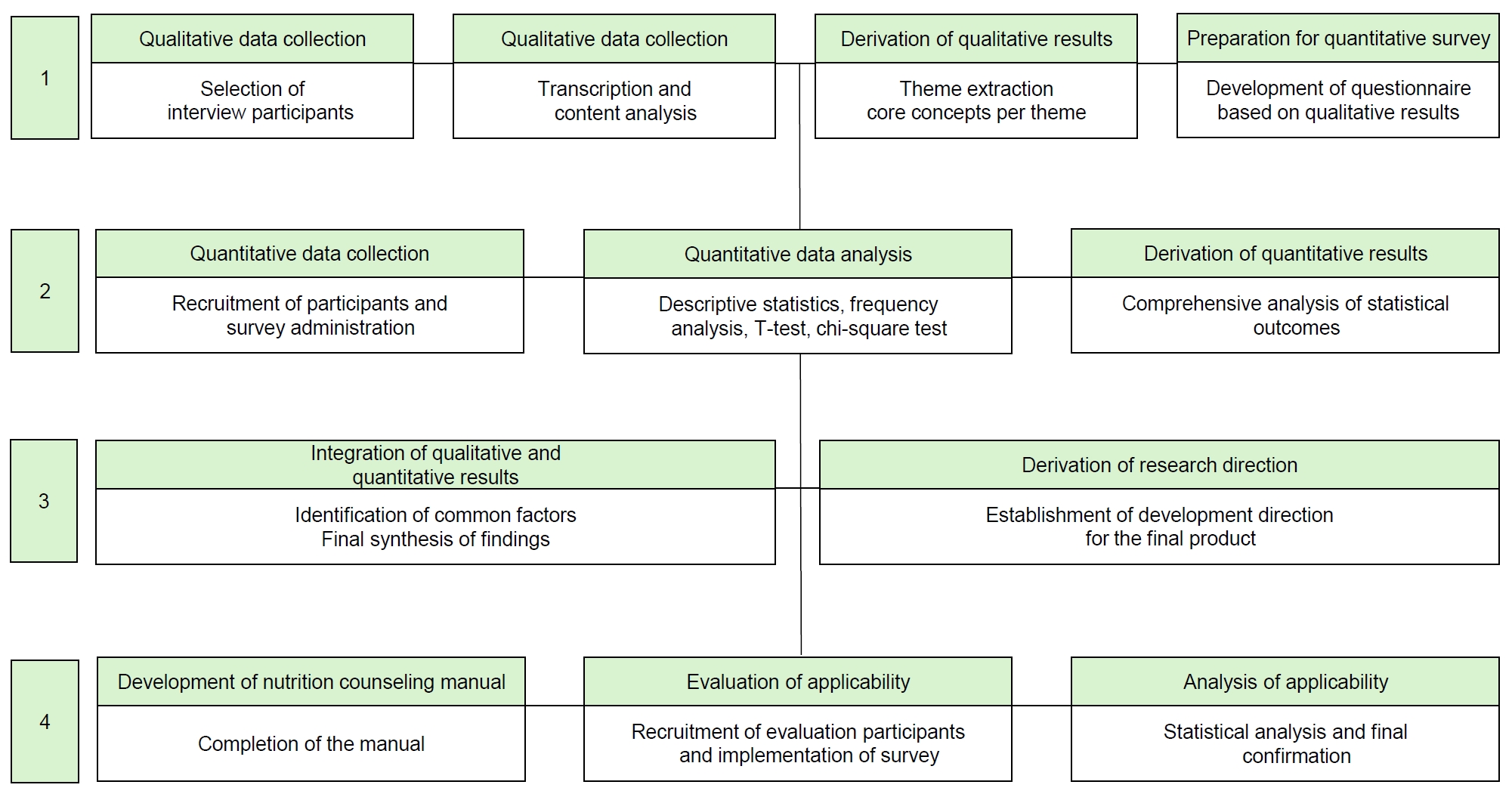Current issue
- Page Path
- HOME > Browse Articles > Current issue
Editorial
- [English]
- Indexing of the Korean Journal of Community Nutrition in PubMed and PubMed Central: a milestone toward global recognition
- Ji-Myung Kim
- Korean J Community Nutr 2025;30(5):321-322. Published online October 31, 2025
- DOI: https://doi.org/10.5720/kjcn.2025.00213
- 48 View
- 2 Download

Review
- [English]
- Evaluation and standardized dietary strategies for dysphagia in older adults: a narrative review
- Jean Kyung Paik
- Korean J Community Nutr 2025;30(5):323-330. Published online October 31, 2025
- DOI: https://doi.org/10.5720/kjcn.2025.00290

-
 Abstract
Abstract
 PDF
PDF - Objectives
This review aimed to elucidate the characteristics of dysphagia and age-related swallowing changes (presbyphagia) in older adults and to comprehensively examine assessment tools and standardized meal management strategies applicable in community settings to propose effective meal management strategies for healthy longevity.
Methods
Domestic and international literatures were analyzed regarding the definition and causes of dysphagia, physiological and structural characteristics and clinical impacts of presbyphagia, assessment and diagnostic tools (K-EAT-10 and K-DRACE), and the International Dysphagia Diet Standardization Initiative (IDDSI).
Results
Dysphagia compromises safe swallowing and nutritional intake in older adults, leading to serious complications, such as aspiration pneumonia, dehydration, malnutrition, sarcopenia, and reduced quality of life. The K-EAT-10 and K-DRACE proved effective for rapid screening of dysphagia risk in community-dwelling older adults. Moreover, texture-modified meals and viscosity adjustments based on the IDDSI standards are useful for reducing the risk of aspiration and improving nutrient intake. Meals can be classified as liquidized, minced, chopped, or regular, allowing for individualized management.
Conclusion
Presbyphagia is a multidimensional problem, and the integrated use of assessment tools and standardized meals is crucial. Community-based dysphagia management programs and collaboration among dietitians and healthcare professionals are needed to improve the nutritional status and quality of life of older adults.
- 51 View
- 1 Download

Research Articles
- [English]
- Sex differences in the association between Korean Healthy Eating Index and type 2 diabetes mellitus in Korean adults: a prospective cohort study
- Yeeun Park, Minji Kim, Kyong Park
- Korean J Community Nutr 2025;30(5):331-340. Published online October 31, 2025
- DOI: https://doi.org/10.5720/kjcn.2025.00227

-
 Abstract
Abstract
 PDF
PDF Supplementary Material
Supplementary Material - Objectives
Dietary quality is a modifiable determinant of type 2 diabetes mellitus (T2DM). However, evidence on the Korean Healthy Eating Index (KHEI) and sex-specific differences in its association with T2DM risk remains limited. This study is to examine the longitudinal association between KHEI and incident T2DM in Korean adults, with a focus on potential sex differences.
Methods
We analyzed 56,000 adults (37,684 women and 18,316 men) from the Health Examinee cohort of the Korean Genome and Epidemiology Study. Dietary intake was assessed using a validated semi-quantitative food frequency questionnaire, and KHEI scores were constructed based on national guidelines. Incident T2DM was defined using physician diagnosis, treatment history, or biochemical criteria. Cox proportional hazards models and restricted cubic spline analyses were applied to evaluate associations, with adjustments for demographic, lifestyle, and clinical covariates.
Results
Over a median follow-up of 4.2 years, 2,252 women and 1,776 men developed T2DM. Women in the highest quartile of KHEI had a 18% lower risk of T2DM compared with those in the lowest quartile (hazard ratio [HR]: 0.82, 95% confidence interval [CI]: 0.71–0.93; P for trend = 0.007). In men, no significant association was observed (HR: 1.11, 95% CI: 0.95–1.29). The interaction by sex was statistically significant (P for interaction < 0.05). Spline analyses indicated a linear inverse association between KHEI and T2DM risk in women, whereas no trend was evident in men.
Conclusion
Higher diet quality, as measured by the KHEI, was associated with a reduced risk of T2DM in women but not in men, suggesting sex-specific effects of dietary patterns on diabetes prevention. These findings highlight the need for tailored nutritional strategies that consider biological and behavioral differences between women and men in Korea.
- 41 View
- 2 Download

- [English]
- Self-reported weight change and diet quality in relation to metabolic syndrome among Korean cancer survivors: a cross-sectional study using the Korea National Health and Nutrition Examination Survey 2019–2021
- Hye Won Kim, Ji-Myung Kim
- Korean J Community Nutr 2025;30(5):341-351. Published online October 31, 2025
- DOI: https://doi.org/10.5720/kjcn.2025.00241

-
 Abstract
Abstract
 PDF
PDF - Objectives
Using data from the 2019‒2021 Korea National Health and Nutrition Examination Survey, we examined the association between dietary quality and metabolic syndrome by self-reported weight change among adult Korean cancer survivors.
Methods
We analyzed 340 cancer survivors (≥ 5 years post-diagnosis) by one-year weight change (stable, loss, and gain). Dietary quality was assessed using the Korean Healthy Eating Index (KHEI), and metabolic syndrome was defined according to standard criteria. Relative risks (RR) were estimated using a modified Poisson regression.
Results
The weight loss group was older than the weight gain group (P < 0.001). Females were more prevalent in the loss and gain than in the maintenance group (P = 0.008). Hypertension prevalence was highest in the loss and lowest in the gain group (P = 0.028); other risk factors were similar. The gain group had the highest body mass index (P = 0.011). KHEI scores were highest in the maintenance (66.59 ± 0.76) and lowest in the gain group (60.42 ± 1.77; P = 0.006), with significantly lower whole grain (P = 0.036) and fruit intake (P = 0.014). Compared with the maintenance group, the gain group demonstrated higher risks of metabolic syndrome (RR: 2.07, 95% confidence interval [CI]: 1.40–3.06; P < 0.001), abdominal obesity (RR: 1.93, 95% CI: 1.36–2.74; P < 0.001), and impaired fasting glucose (RR: 1.70, 95% CI: 1.23–2.34; P < 0.01). Within the gain group, participants in the lowest KHEI quartile had increased risks of metabolic syndrome (RR: 2.81, 95% CI: 1.06–7.43; P < 0.05) and hypertriglyceridemia (RR: 7.29, 95% CI: 1.54–34.61; P < 0.05).
Conclusion
Accordingly, weight change and dietary quality may critically affect the metabolic health of cancer survivors. Lifestyle management, including weight control and tailored diets, may help prevent metabolic disorders and support long-term health.
- 39 View
- 1 Download

- [Korean]
- Effects of primary caregivers’ food literacy, social support, food environment, and household income on the nutritional status of school-aged children: a cross-sectional study
- Seyeon Park, Ji-Yun Hwang, Sohyun Park, Hyun Joo Ryou, Jieun Oh
- Korean J Community Nutr 2025;30(5):352-363. Published online October 31, 2025
- DOI: https://doi.org/10.5720/kjcn.2025.00248

-
 Abstract
Abstract
 PDF
PDF - Objectives
The dietary habits of school-aged children play a critical role in their growth and development, and are strongly influenced by the home environment. Household income is closely associated with caregivers’ food literacy, social support, and food environment. This directly affects the nutritional status of children. This study aimed to provide evidence to inform policies and educational programs for improving dietary habits in children, and to establish a foundation for tailored support strategies for low-income families.
Methods
This cross-sectional study included 846 primary caregivers of school-aged children from 17 regions across Korea, recruited through an online survey. Household income, caregivers’ food literacy, social support, and food environment were assessed. Nutritional status in children was measured using the Nutrition Quotient for Children (NQ-C). Statistical analyses included descriptive statistics, chi-square tests, one-way analysis of variance (ANOVA), analysis of covariance (ANCOVA), correlation analyses, and multiple linear regression.
Results
Caregivers from higher income households demonstrated significantly greater food literacy and social support (P < 0.001). Children from these households showed high balance scores and a large proportion of these children were in the “high” NQ-C grade. The NQ-C score in children was positively correlated with food literacy (r = 0.425), social support (r = 0.471), and the food environment (r = 0.235) (P < 0.001). Multiple regression analysis showed that food literacy (β = 0.256) and social support (β = 0.348) were significant predictors of nutritional status in children.
Conclusion
This study confirmed that the nutritional status in children is not only determined solely by household income but is also mediated by caregivers’ food literacy, social support, and food environment. These findings highlighted the limitations of providing only economic support. The findings underscore the need for multifaceted interventions such as strengthening parental nutrition education, expanding social support networks, and improving access to healthy foods.
- 49 View
- 2 Download

- [Korean]
- Factors associated with nutritional risk among disabled persons in the Republic of Korea: a cross-sectional study using 2020 Disability and Life Dynamics Panel
- Seong-Ah Kim, Seul Ki Choi
- Korean J Community Nutr 2025;30(5):364-375. Published online October 31, 2025
- DOI: https://doi.org/10.5720/kjcn.2025.00262

-
 Abstract
Abstract
 PDF
PDF - Objectives
Persons with disabilities face heightened nutritional risks due to barriers in dietary management, yet research remains limited. This study examined the nutritional health status and associated risk factors among disabled adults in Korea.
Methods
Data were drawn from the 2020 Disability and Life Dynamics Panel, a nationally representative survey of registered disabled Koreans aged ≥ 20 years. Nutritional health was assessed using the Nutrition Screening Initiative checklist and categorized as low, moderate, or high risk. Multivariate multinomial logistic regression was applied to identify predictors of nutritional risk.
Results
Among adults with disabilities aged 20–64 years, the prevalence of low, moderate, and high nutritional risk was 62.6%, 19.8%, and 17.5%, respectively. In the ≥ 65 years group, the distribution was 56.8% (low), 22.0% (moderate), and 21.2% (high). Moderate to high nutritional risk was most prevalent among individuals with facial deformity or internal organ disability (51.2%) in the 20–64 years group, and those with mental disabilities (61.7%) in the ≥ 65 years group. Significant predictors of high nutritional risk included living alone, lowest income quartile, chronic disease, depressive symptoms, and perceived underweight for both age groups. Compared with visual or speech impairments, facial deformity or internal organ disability (in the 20–64 years group) and physical disability (in the ≥ 65 years group) were significantly associated with moderate or high nutritional risk.
Conclusion
Nearly 40% of disabled Koreans are at nutritional risk. Tailored dietary interventions that address disability type, socioeconomic status, and health conditions are required to reduce disparities in nutritional health.
- 47 View
- 1 Download

- [Korean]
- A study on the development of nutrition counseling manual and curriculum for the disabled in Korea: a mixed-methods study
- Kyoung-Min Lee, Woo-jeong Kim, So-young Kim, Young-mi Park, Hwa-young Yoon, Min-Sun Jeon
- Korean J Community Nutr 2025;30(5):376-388. Published online October 31, 2025
- DOI: https://doi.org/10.5720/kjcn.2025.00192

-
 Abstract
Abstract
 PDF
PDF - Objectives
Individuals with disabilities require targeted interventions to ameliorate disability-related conditions and improve overall health status. Nutritional challenges and counseling needs vary according to the type of disability, necessitating comprehensive assessments of dietary habits, physical activity, and food intake. Compared to traditional education, nutrition counseling offers a more sustainable and environmentally adaptable approach that effectively addresses individualized nutritional issues. Therefore, this study aimed to develop and evaluate a practical nutrition counseling manual and meal guidelines for people with disabilities in Korea, addressing their diverse dietary needs and improving nutritional care in social welfare facilities.
Methods
A four-stage integrated research design was employed. Stage 1 involved qualitative research through in-depth interviews with 11 facility staff. In Stage 2, a nationwide survey (n = 249) was conducted based on the results of the interviews. Stage 3 integrated both qualitative and quantitative findings. Stage 4 focused on developing and evaluating a nutrition counseling manual and five types of meal guidelines through feedback from 26 nutritionists at 24 Korean Centers for Social Welfare Foodservice Management.
Results
Six major nutrition counseling topics were identified: healthy eating, managing salt and sugar intake, dysphagia diet, appropriate intake, and hygiene. The manual and guidelines demonstrated high field usability, with average satisfaction scores of 3.98 and 3.99, respectively.
Conclusion
The integrated study resulted in the development of a specialized nutrition counseling manual and handbook for individuals with disabilities in Korean social welfare facilities. The materials were revised and improved based on practical evaluations by dietitians, enhancing their field applicability. These tools are expected to contribute to better dietary management and health promotion among facility residents. The developed materials reflect the real-world needs of people with disabilities and offer practical tools for effective nutrition counseling and dietary management in institutional settings.
- 35 View
- 1 Download


 KSCN
KSCN


 First
First Prev
Prev



